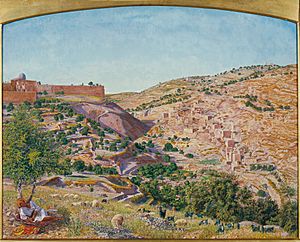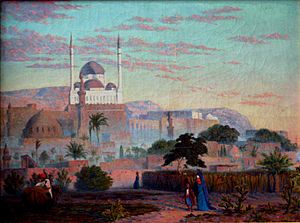Thomas Seddon facts for kids
For the New Zealand politician, see Tom Seddon
Thomas Seddon (born August 28, 1821, in London – died November 23, 1856, in Cairo) was an English landscape painter. He was part of a group called the Pre-Raphaelite movement. Seddon was known for his bright and very detailed paintings of places like Brittany, Egypt, and Jerusalem.
Contents
Thomas Seddon's Early Life and Art Journey

Thomas Seddon was born in Aldersgate Street in the City of London. His father was also named Thomas Seddon and was a famous cabinet-maker. Young Thomas went to a special school that used the Pestalozzian system, which focused on hands-on learning.
After school, he worked for his father. In 1841, he went to Paris to study ornamental art, which is about making things look beautiful with decorations.
Becoming an Artist
Even though he worked in the family business, Thomas really wanted to be a painter. He kept studying art and design. He even won a silver medal in 1848 for his design of a fancy sideboard (a type of furniture).
He also took drawing lessons and attended art classes. In 1849, he traveled to North Wales, visiting Betws-y-Coed. This place was popular with artists, and it's where he first seriously tried landscape painting. The next year, he went to Barbizon in France and painted some oil studies.
Joining the Pre-Raphaelites
Around 1848, Seddon met Ford Madox Brown, who was part of the Pre-Raphaelite movement. This group of artists wanted to paint in a new, detailed, and colorful way, inspired by art before the famous artist Raphael.
In 1850, Seddon worked with Brown in his studio. He also helped start an art school for working men in Camden Town. Later that year, he became very ill. After recovering, he decided to leave his father's business and focus entirely on painting.
His first painting shown at the Royal Academy was called Penelope. He visited Wales again and then went to Dinan in Brittany, France. A landscape he painted there was shown at the Royal Academy the next year.
Adventures in Egypt and Jerusalem
In 1853, Seddon got ready for a big trip to Egypt. He traveled with William Holman Hunt, another founder of the Pre-Raphaelite Brotherhood. Seddon arrived in Alexandria on December 6 and then went to Cairo.
Painting in the Middle East
Seddon and Hunt set up camp near the famous Pyramids. After a change of plans, they decided to travel to Jerusalem. They sailed from the Nile River in late May.
In Jerusalem, Seddon set up his tent on a hill. From there, he had an amazing view of the Garden of Gethsemane and the Mount of Olives. He spent a lot of time painting his detailed landscape called Jerusalem and the Valley of Jehoshaphat from the Hill of Evil Counsel. This painting showed the area exactly as he saw it. He left Jerusalem for France in October 1854.
Finishing His Masterpiece
Even though he painted most of Valley of Jehoshaphat on location, Seddon continued to work on it in Dinan. He also worked on other paintings and watercolors he started in Jerusalem.
He finally finished the painting with some help from Hunt after returning to London in January 1855. He showed it for the first time in his studio in Berners Street. His paintings of Eastern places were shown again the next year.
Later Life and Legacy
In October 1856, Seddon visited Cairo again. Sadly, he became very ill and died there on November 23.
After his death, his paintings were shown in an exhibition. His famous painting, Jerusalem and the Valley of Jehoshaphat, was bought by people who donated money and was given to the National Gallery.
The famous art critic John Ruskin praised Seddon's paintings of Egypt and Palestine. He said they were the "first landscapes uniting perfect artistical skill with topographical accuracy." This means Seddon's paintings were both beautiful art and perfectly accurate maps of the places he painted.
Thomas Seddon's brother, John Pollard Seddon, wrote a book about his life in 1859.
See also
- List of Pre-Raphaelite paintings - This list includes some of Thomas Seddon's artworks.


